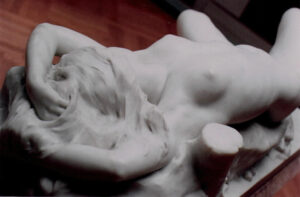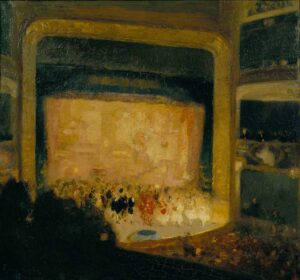Never before published in print, a lecture given by Clement Greenberg in Mountain Lake, Virginia in October 1980.

Art and life. Art and life as lived can be seen as one and inseparable only when art is experienced sheerly as a phenomenon among other phenomena. Art experienced as art, art experienced aesthetically, “properly,” art experienced at what’s called aesthetic distance, is not a phenomenon. What else is it then? I can’t say because art can’t be defined, or has never been satisfactorily defined. Aesthetic distance means separation, a kind of transcendence, if you please. And that word transcendence has gotten so fashionable I use it almost apologetically. Art as art takes place away from life as lived, is experienced as other than the life-world, to use Donald Kuspit’s phrase. And this otherness is part of art’s gift.
The determining ultimate intention and end of art, of the aesthetic in general, is qualitative. The only and the final question for art is whether it is good or bad and how good or bad. This is decided according to a scale of value decided by taste. Taste has to do only inexclusively with the aesthetic, with aesthetic value. And aesthetic value is ultimately created by taste.
The only legitimate demand that can be put to art is that it be good, aesthetically satisfying, and this demand can be made only by taste. The aesthetic happens to be among the final satisfactions of life as lived, an ultimate satisfaction of value in itself, and not a means or an instrument to an end beyond itself. But being an ultimate end doesn’t mean being a supreme one. Happiness in life as lived, life in the life-world, happens to stand higher. By the same token, morality becomes a means, a means to happiness.
Morality is not an end in itself in spite of Kant’s categorical imperative. Happiness is an end in itself, and I would agree with Kant that in order to be happy you have to be a moral being and live morally. But still, morality is not an end in itself; it remains a means. Very unlike the aesthetic which serves only itself and a kind of distanced satisfaction. The happiness it provides – aesthetic satisfaction or aesthetic felicity – is too distant. This distanced happiness is not the same as the supreme happiness that can be found only in life as lived.
Now, art converts everything specifiable, identifiable, into means and that includes morality. Just as morality is a means in lived life, so it’s a means in art. But unlike almost everything else, morality is not a flexible means for art or in art. Literature shows that morality inside art won’t lend itself with aesthetic profit to anything that makes it violate itself. A fiction celebrating cruelty will fail as art because it collapses aesthetic distance by offending too much in terms of life as lived. Art breaks out of its sphere when it uses something that too flagrantly violates morality without being subsequently corrected. Art simply can’t afford to do that. There may be exceptions, but I don’t know of them.
Now, the fact that morality is a means and that art or the aesthetic is an end, an ultimate value, again does not mean that morality, the instrumental value, stands lower in the hierarchy of values than the aesthetic. Not at all. Life as lived has the say and the final say. And it says that art is a value in itself, while it possess lesser value than morality as a means to value. Morality serves lived-life and there’s no higher court of appeal than lived-life. Sure, art is a part of life, it embellishes life and is one of the satisfactions of life, but it is still subordinate to other ends. Even though it is not a means or an instrument, it is subordinate.

Having put art in its place, I want to give that place its due. Once again, of art in its own place, all that can be asked is that it work. That it succeed. That it satisfy as art. It serves life as lived by serving itself, and when it serves itself satisfactorily, it stops all further demands or questions.
Then art has to observe certain limits like the one I pointed out with regard to morality, and maybe only that limit doesn’t change this. Anyhow, it seems that it’s literature alone that’s had to observe this limit. Music and visual art and dance have been utterly unconstrained with respect to morality, or almost so. Try going into the moral sense or implications of a piece of music or a painting or a sculpture. There are pictures that dwell, in effect, on the sadism involved in the depiction of a martyrdom. There’s Grönewald’s Crucifixion, which seems to savor its gruesomeness. Yet when the art is good enough, the sadism is obliterated or, to use that damned word again, “transcended,” and only the art is left. The fact that conceptual meaning is absent may be the advantage of the “purity” of visual art, and of music, too, as against literature with its “impurity”; but I think that this kind of distinction can go too far. The fact is, that art of any kind, literature included, doesn’t operate as a moral or any other kind of agent. It operates only for itself and only for what we can get from that self in abstraction, as it were, from whatever else. But again I have to be very careful in what I say. Culture is a civilizing force and art is part of culture, yes; but art does its civilizing, refines sensibility and expands sensibility, most effectively when it’s itself and serves itself. When it does that, art is morally, politically, and socially indifferent.
Of course, this doesn’t mean that art takes place in a vacuum. Art is influenced by everything, or almost everything, of course. Life is lived, crowds in, and fills art. Art has to feed off life that is lived. We are at a point where we have to do some abstracting again. The recognition of how indissoluble art is from life can be overdone. We have become able to appreciate art from all times and all places. That is, we’ve become able to overcome historical circumstances in experiencing art. Maybe artists can’t do that in making art, but the beholder seems to be able to do that. That he’s becoming increasingly able to do that in later years, is a subtopic all by itself. The catholicity of taste in the West is a unicum. It’s unique in history, far as I know, but let’s leave that aside for the moment.
The further fact is that hypothetically, in principle, the artist can largely transcend or abstract himself from every historical circumstance except that of art itself. That is, he cannot separate himself from the tradition or course of the particular art he practices. This point is a little moot and I won’t go into it further here.
At any rate, artists can, and have, and do, work in

on – is that art qua art can best be dealt with by being “bracketed off,” as phenomenologists would say, in order to find out more about the experiencing and making of it. Actually we do bracket off the history and practice of science and medicine and engineering, and many other disciplines, in order to scrutinize them better. As we try to scrutinize them in themselves, we do a kind of phenomenological reduction.
Well, I do that kind of bracketing myself when as a critic I deal with art, and not only with recent art. When I started writing criticism I used to bring in at least the temper of the times, and I used to do a lot more interpreting than I do now. Years ago, I left off doing that. Practice and experience instructed me here. I found out that for myself it was too easy, and too deceptive, to interpret art in terms of factors other than art. It didn’t cast enough light on either art or these other factors, except maybe incidentally. I found out I was usually saying things that any intelligent reader already knew. As, in saying that Matisse’s Nice period reflected post-1918 hedonism of France and of Western Europe. Now and then I had to ask myself why pre-1914 art didn’t reflect even greater hedonism of the Belle Époque of the 1900’s. Then I said, “Well…”; then I’d get into something that had to do with art only very indirectly. I found out that this business of investigating how art reflected the temper of its times didn’t help so much – even when other people did it.
I think I’ve made certain points in too extreme a way in order to emphasize them, and I want to qualify some of what I’ve just said. Assessing the temper of the times, our times or any times of the past, is an interesting topic all by itself; and it can be a fruitful one all by itself. Sometimes art is part of the evidence or the temper of the times. But art can also be tricky evidence of the temper of the times …it often comes down to saying post hoc propter hoc. If something happened after this, then it was caused by this; or if something happened at the same time as this, it had necessarily to do with this. That was part of the facility with which art historical interpretation could be practiced. One example for me is the case of Abstract Expressionism. Is Abstract Expressionism evidence of the temper of post-war America? I’d say not, not as I experienced this country after the war. No, I’d say that Abstract Expressionism reflected the temper of the times in the 30’s when all the artists concerned were younger. Then I began to surmise, well, maybe that is how life as lived in general affects art and religion and so forth. It’s what happened to you in your youth. That’s been said before, but without furnishing enough evidence.
I come back to morality. Moral statements are sometimes there and sometimes not there in the best art of the past. All the same, I repeat: asking art to serve a moral, or any other end except aesthetic quality, is to make an illegitimate demand on art. The experience of art, the reported experience of art, the experience of art that’s been acted on, the experience of art with its satisfactions and dissatisfactions, shows that.
Clement Greenberg,
Transcript of a talk given October, 1980 at the Moral Philosophy and Art Symposium, Sponsored by Virginia Tech and the National Endowment for the Humanities, Mountain Lake, Virginia
